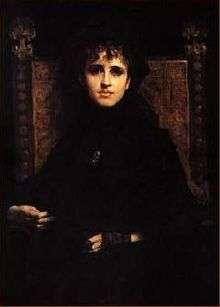Geneviève Halévy

Geneviève Halévy, later Geneviève Bizet and Geneviève Straus (Paris, 26 February 1849 – 1926), was a French salonnière. She inspired Marcel Proust as a model for the Duchesse de Guermantes and Odette de Crécy in À la recherche du temps perdu.
Life
Geneviève Halévy was the daughter of the composer Jacques-Fromental Halévy and his wife, née Léonie Rodrigues-Henriques, both Jewish. Geneviève Halévy's youth was sad: she lost her father when she was 13 years old, her elder sister when she was 15 years old, and her mother suffered from periods of mental instability. In 1869, she married Georges Bizet, pupil of her father, and gave birth in 1871 to their son Jacques, who became a school friend of Marcel Proust. Bizet died suddenly of a heart attack, in 1875. Geneviève moved to live with her uncle, Léon Halévy, and opened a salon for her cousin Ludovic Halévy, where she helped him in receiving the cream of the artistic society of the time. This was known as Ludovic's Thursdays (Les jeudis de Ludovic).
After a few years, she opened her own salon where distinguished society, such as Baron and Baronness Alphonse de Rothschild, Comtesse Potocka, Duchesse de Richelieu, Comtesse de Chevigné, née de Sade (another model for the Duchesse de Guermantes), etc. could meet with writers and intellectuals such as Guy de Maupassant, Henri Meilhac, Georges de Porto-Riche, Paul Bourget, Paul Hervieu, Joseph Reinach, and of course her cousin Ludovic.
In 1886, she married the lawyer Émile Straus, an acquaintance of the Rothschild family, and her salon became increasingly fashionable: she received Robert de Montesquiou and his cousin Comtesse Greffulhe, painters and journalists. Many supporters of Dreyfus socialized at Mme Straus's salon, amongst them Marcel Proust who was one of the first intellectuals to sign a petition in L'Aurore at the time of the Dreyfus Affair. After the Affair the salon became less prominent.
After 1910, Mme. Straus became increasingly depressed, and cut herself off from society. Her son committed suicide in 1922, a few weeks before Proust's own death, and she died in 1926.
Sources
- Andrée Jacob, Il y a un siècle, quand les dames tenaient salon, Paris, Ed. Arnaud Seydoux, 1991
- Painter, George Duncan: Marcel Proust: a biography, London, Chatto & Windus, 1959